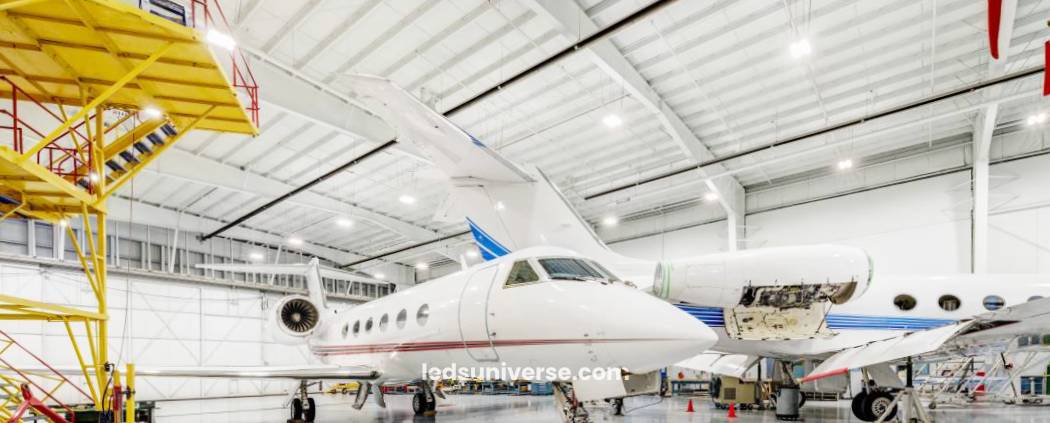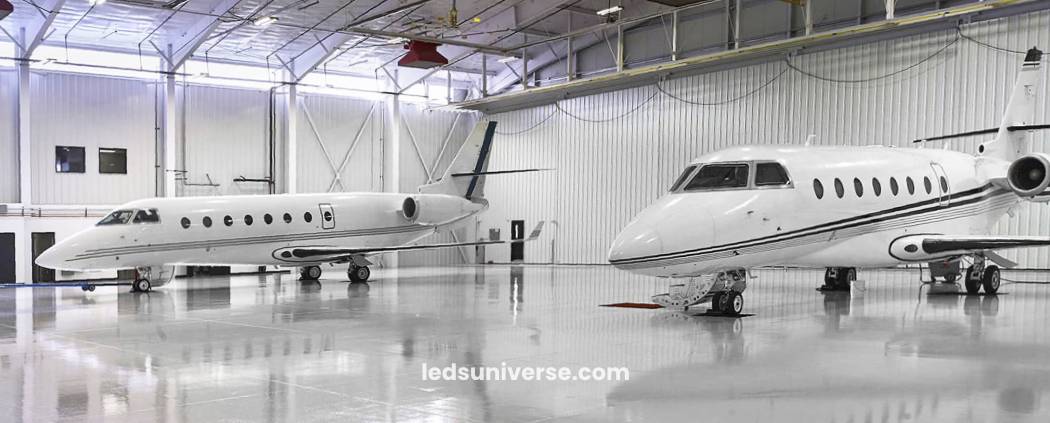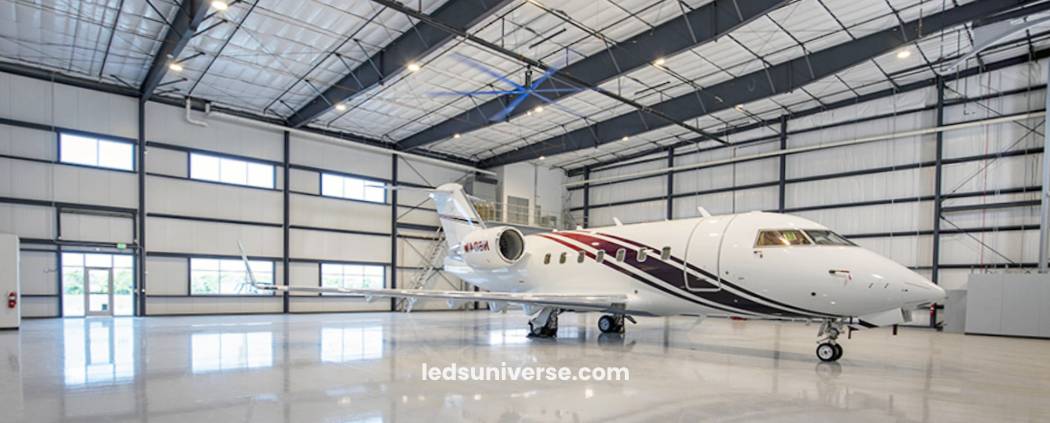Commercial hangars are vast, dynamic environments that demand reliable, high-quality lighting to support a wide range of activities—from routine maintenance to detailed inspections. However, these large spaces often consume significant energy to maintain appropriate illumination levels around the clock. Striking the right balance between effective lighting and energy efficiency is necessary not only for operational performance but also for reducing costs and environmental impact. This article explores key strategies and technologies that help maintain energy-efficient lighting in commercial hangars without compromising safety or productivity.
Table of Contents
ToggleRecommended Illumination Levels for Commercial Hangars
Commercial aircraft hangars serve as critical hubs for a wide spectrum of aviation activities, ranging from logistical coordination to intricate maintenance procedures and detailed inspections. The complexity and diversity of these operations demand a lighting design that supports not just safety and visibility, but also efficiency and accuracy. To meet these requirements, regulatory standards and aviation best practices outline specific illumination benchmarks that vary depending on the function of the space. These standards often reference lux levels, a measure of light intensity perceived on a surface, to define optimal lighting for each type of task.
| Area Type | Recommended Lux Range | Key Application Details |
|---|---|---|
| Storage and Transit Spaces | 100 – 200 lux | Basic navigation, equipment retrieval, and safety lighting |
| General Maintenance Areas | 300 – 500 lux | Mechanical tasks, reading labels, gauges, and tools |
| Detailed Inspection Zones | 750 – 1000 lux | Precision inspection for small defects, corrosion, surface issues |
Varying Lighting Requirements Across Functional Zones
Lighting needs within a hangar are not uniform; they differ significantly depending on the activities taking place. Storage areas, transit pathways, maintenance bays, and inspection stations all serve different roles, and as such, demand distinct light levels. In general, recommended illuminance levels range from 100 lux to 1000 lux, with brighter settings needed for detailed visual work and more modest lighting sufficient for navigation or passive storage. Maintaining adequate light intensity across the entire facility is only part of the equation—uniformity, glare control, color accuracy, and beam control also play crucial roles in supporting aviation operations.
Illumination for General Maintenance Areas
Aircraft maintenance zones are typically dynamic environments where technicians perform essential duties like engine diagnostics, fuel system checks, brake evaluations, and hydraulic repairs. These tasks require dependable and consistent lighting across a large surface area. To support such work, it is generally advised to maintain illumination levels between 300 to 500 lux. This intensity allows personnel to accurately read labels, gauges, and instruments, while also reducing eye strain over extended working hours.
Given that fixtures in these zones are often mounted at heights between 8 to 14 meters, it becomes essential to use luminaires designed with diffusers or anti-glare shields. These design elements minimize the harshness of light and promote better visibility across tool benches, aircraft fuselages, and floor-level components. Ensuring uniform spread of light across these zones contributes to both visual comfort and operational efficiency, especially in tasks that involve repetitive motion or scrutiny of mechanical components.

Higher Lighting Levels for Detailed Inspections
In contrast to general maintenance, inspection zones are designed for precision-critical evaluations, where technicians are expected to identify the smallest of defects, such as cracks less than a millimeter wide or early-stage corrosion. These inspections are central to aircraft airworthiness and safety, and therefore demand significantly higher lighting levels, usually ranging from 750 to 1000 lux.
Beyond brightness, color fidelity becomes a crucial factor in inspection work. High Color Rendering Index (CRI) ratings of 80 or more are recommended to ensure accurate color differentiation and enhanced visibility of fine textures. Additionally, beam angle control plays a vital role in inspection tasks. Fixtures with 30° to 60° beam angles offer focused illumination that can be directed exactly where it’s needed, whether it’s the surface of a turbine blade or the inner lining of an avionics panel. Adjustable task lights with flexible mounts further enhance this capability, allowing inspectors to tailor lighting to the contours and complexity of the component being examined.
Lower Lux Levels for Storage and Transit Spaces
Not all areas within a hangar demand the same level of brightness. Storage areas and transit corridors require less intensive lighting, with recommended lux levels generally falling in the range of 100 to 200 lux. These spaces are typically used intermittently and are not the focal point of precision work. The lighting here should prioritize safety and navigability, ensuring that employees can walk through, retrieve equipment, or conduct basic inventory tasks without visual strain.
In such zones, motion-activated lighting systems with automatic shut-off timers ranging from 5 to 15 minutes are particularly effective. These systems help reduce energy consumption without compromising functionality. Because these lights are usually mounted at lower heights between 3 to 6 meters, narrower beam spreads can be employed to localize illumination directly on shelving units, walking paths, or equipment bays. This targeted approach not only improves lighting efficiency but also contributes to operational sustainability.
Balancing Brightness with Even Light Distribution
Ensuring a hangar meets target lux levels is only part of achieving good lighting design. Equally critical is the uniformity of light distribution, which refers to the ratio between the average and minimum levels of illumination across a space. For commercial aviation facilities, maintaining a uniformity ratio of at least 0.7 is essential. This helps prevent uneven patches of lighting that could lead to visual confusion, missed defects, or operator fatigue.
In hangars with high ceilings—especially those exceeding 15 meters—achieving such uniformity can be challenging. It often necessitates the use of wide-beam or asymmetric optic designs that spread light more consistently across both vertical and horizontal planes. Additionally, reflectors and careful fixture placement can help eliminate shadows cast by overhead cranes, HVAC ducts, or steel trusses.
Smooth Transitions Between Differently Lit Areas
One often-overlooked aspect of hangar lighting is how different lighting zones interact. Moving from a brightly lit inspection area into a dimmer storage corridor, for example, can cause temporary visual disorientation or even glare-related discomfort. To avoid this, lighting transitions between zones should not exceed 30% in luminance variation. This smooth transition helps maintain depth perception and spatial awareness, reducing the likelihood of accidents or mistakes as personnel move from one operational space to another.
Thoughtfully designed lighting transitions are particularly critical at ramp entries, doorways, or shared-use spaces where activities converge. By preserving a visual rhythm throughout the hangar, designers ensure that technicians and staff can work more safely and with greater confidence.
Elements Influencing Illumination Requirements

Lighting a commercial hangar is a multifaceted challenge that goes beyond simply installing fixtures. The level of illumination required in each area is shaped by a combination of physical, operational, and environmental factors. Understanding these elements is essential for crafting a lighting plan that not only meets functional needs but also enhances energy efficiency, safety, and user comfort.
Size and Layout of the Hangar
The physical dimensions and architectural configuration of a hangar are among the first considerations when determining appropriate lighting strategies. Larger facilities naturally encompass more space, often with ceiling heights exceeding 12 or even 20 meters. This vertical distance alone creates unique lighting challenges, particularly in terms of intensity and uniformity. A larger space demands higher lumen output or a greater number of fixtures to ensure comprehensive coverage.
In more complex layouts—those that include mezzanine levels, inspection pits, separate work zones, or tall equipment bays—uniform lighting becomes even harder to achieve without strategic design. Overhead cranes, support beams, and suspended structures may cause shadows or obstruct light paths, requiring fixtures to be carefully placed to avoid dark spots. These spaces often benefit from a layered lighting approach, where general ambient light is supplemented with task-specific lighting tailored to each activity area. Conducting a detailed spatial analysis helps avoid the common pitfalls of over-lighting certain sections or leaving others inadequately illuminated, which can negatively impact both visual comfort and energy use.
Nature of Tasks Performed
Equally important is a thorough understanding of the specific activities carried out within the hangar. Different tasks demand varying levels of visibility and precision. For instance, visual inspections, avionics testing, and component certification require light levels high enough to detect the smallest imperfections, where even minor glare or shadowing can obscure critical details. These tasks benefit from focused beam lighting, high Color Rendering Index (CRI) values, and flexible adjustment options.
In contrast, spaces used primarily for vehicle transit, cargo storage, or basic administrative functions don’t require intense lighting. These areas can operate safely and efficiently at lower lux levels, often between 100 and 300 lux. Designing with task specificity in mind ensures that light is deployed where it’s most needed, reducing energy consumption while enhancing worker productivity. Rather than applying a one-size-fits-all lighting standard across the entire hangar, a targeted approach produces operationally appropriate and cost-effective results.
Type, Placement, and Reflectivity of Fixtures
The selection and arrangement of light fixtures significantly influence how illumination behaves within the hangar space. Whether choosing high bay luminaires, linear strips, or LED floodlights, the fixture type must align with the hangar’s structural and functional needs. Equally vital is fixture placement and orientation. Even the highest-lumen lights can underperform if mounted too high, misaligned, or spaced inconsistently.
Beam angle and mounting height must be calculated in tandem with fixture spacing to ensure maximum light efficiency and minimal overlap or dark zones. In hangars with highly reflective interiors—such as white walls, polished floors, or metallic ceiling surfaces—ambient light can be amplified and dispersed more evenly. This reflectivity reduces the total lighting load required, improving energy performance. On the other hand, dark-painted or matte-finish environments tend to absorb rather than reflect light, meaning higher wattage or more fixtures are needed to maintain adequate visibility. Evaluating surface reflectivity as part of the lighting plan helps optimize fixture count and energy use.
Availability of Natural Light
Natural daylight, when properly harnessed, can become a valuable asset in a hangar’s overall lighting strategy. Large, open structures often have the advantage of roof-mounted skylights or side-facing windows, which provide abundant sunlight during daylight hours. The presence of natural light not only reduces reliance on artificial sources but also improves the overall ambiance of the workspace, contributing to visual comfort and employee well-being.
However, daylight availability varies significantly based on the building’s orientation, location, and seasonal shifts. To make the most of this resource, many hangars incorporate daylight harvesting systems, which adjust artificial lighting levels based on real-time sunlight conditions. Automated dimming controls and photocell sensors ensure a seamless transition between natural and artificial light sources, maintaining consistent visibility without wasting energy. In spaces like open repair bays and administrative offices, this integration can lead to substantial operational savings while also supporting sustainability goals.
Environmental Conditions and Maintenance
Commercial hangars are frequently subjected to challenging environmental conditions that can degrade lighting systems over time. Jet fumes, airborne dust, oil mist, and moisture can all accumulate on lighting fixtures, reducing light output and creating maintenance burdens. In extreme cases, temperature fluctuations may even affect the performance or lifespan of sensitive electrical components.
To counteract these issues, lighting systems must be designed for durability and ease of maintenance. Fixtures with IP-rated enclosures, corrosion-resistant coatings, and thermal protection mechanisms are better equipped to withstand harsh conditions. Scheduled cleaning and inspection routines are equally vital, ensuring that dust-covered lenses, cracked housings, or degraded mounts don’t go unnoticed. Proactive maintenance helps retain consistent light levels, improves fixture longevity, and prevents the gradual decline in performance that can lead to costly overcompensation with additional lighting. Designing with environmental resilience in mind not only ensures long-term efficiency but also supports safe, uninterrupted operations.
Role of Illumination Levels in Commercial Hangar Lighting

Supporting Diverse Operational Activities
In a working environment where activities span from aircraft repairs and mechanical diagnostics to cargo handling and surface cleaning, the lighting system must support a diverse range of visual tasks. Each of these functions demands a different threshold of brightness. Detailed inspections require precise, high-lux lighting to catch fine imperfections, while equipment handling and coordination benefit from broader, well-distributed illumination that ensures safe movement and accuracy. When illumination aligns with operational demands, it reduces the likelihood of mistakes, protects valuable assets, and keeps downtime to a minimum.
Ensuring Clear Visibility and Safety
At the core of any hangar lighting plan is the commitment to maintaining a safe working environment. Poor visibility in spaces that handle complex machinery, flammable substances, or sensitive avionics systems is not just a performance issue—it’s a safety hazard. Well-lit zones allow personnel to detect potential hazards early, whether it’s a misplaced tool, a slick surface, or a damaged component. Enhanced visibility also helps in reading gauges, labels, and screens accurately, minimizing the risk of human error during high-stakes procedures. Proper lighting directly supports both safety compliance and real-world injury prevention.
Uniform Light Distribution to Reduce Eye Strain
In expansive facilities like aircraft hangars, light uniformity is as important as brightness. When lighting is inconsistent—too dim in one area and harshly bright in another—it can lead to disorientation, visual fatigue, or increased strain on the eyes. Workers who spend hours in such environments may suffer from headaches, reduced focus, or slower task performance. A lighting system designed to spread illumination evenly across work surfaces, equipment, and floor areas not only enhances comfort but also supports long-term productivity and attention to detail. Minimizing shadowed corners or hotspots fosters a visually stable environment where employees can operate at their best.
Enhancing Color and Detail Perception
Many tasks within hangars rely on accurate color judgment and surface evaluation. Whether it’s checking for early signs of corrosion, inspecting fluid lines, or assessing electrical components, the ability to perceive fine visual differences is critical. Lighting with a high Color Rendering Index (CRI)—ideally 80 or above—makes it easier to distinguish true colors and subtle defects. This improved perception directly translates to better diagnostic work, higher maintenance standards, and early detection of potential mechanical issues. It ensures that what might otherwise be missed under poor lighting becomes visible under optimal conditions.
Balancing Brightness with Energy Efficiency and Comfort
Striking the right balance between adequate lighting and energy efficiency is key to maintaining operational sustainability. Over-illuminating a hangar may seem like a precautionary measure, but it can result in uncomfortable glare, unnecessary power consumption, and heat generation. Conversely, dim lighting can compromise task performance and worker safety. An effective lighting design uses smart controls, dimming systems, and zoning strategies to adjust brightness dynamically. This approach not only supports visual comfort and concentration but also aligns with energy conservation goals, reducing the hangar’s carbon footprint and utility costs over time.
Adapting Lighting to Work Zones
Not every part of a hangar has the same lighting requirement. Workstations, inspection bays, fueling areas, and transit lanes each call for tailored illumination strategies. Areas dedicated to precision work often need concentrated, directional light with narrow beam angles and high lux values, while storage areas or corridors can function well with broader, softer lighting at lower intensities. Recognizing and addressing these differences enables a zoned lighting system, where brightness levels are adapted to fit the purpose of each space. This not only enhances functionality but also avoids energy waste by preventing overlighting in areas with minimal activity.
Maintaining Energy-Efficient Lighting in Commercial Hangars
Lighting systems in commercial hangars are among the most energy-intensive components of the facility, driven by vast open areas, high mounting heights, and long operational hours. Achieving energy efficiency without compromising visibility or safety is a critical goal for modern hangar design. With a growing emphasis on sustainability and operational cost reduction, implementing efficient lighting strategies has become not just advisable—but essential.
Sustainable Lighting Strategies for Modern Hangars
A sustainable approach to hangar lighting goes far beyond reducing wattage. It includes integrated controls, long-lasting fixture technology, and intelligent system design that adapts to operational conditions. Hangars, particularly those supporting 24/7 aircraft activity, benefit from a system that balances performance with efficiency. By combining advanced LED technology with responsive control systems and thoughtful design, facility managers can lower utility bills, improve worker satisfaction, and support environmental goals without sacrificing critical illumination levels.
Use of Energy-Efficient Light Sources
Switching from legacy systems such as metal halide or fluorescent fixtures to LED lighting remains one of the most impactful efficiency upgrades. Industrial-grade LEDs are specifically designed for high-ceiling applications and offer greater lumen output per watt, translating directly into lower energy consumption for the same—or better—level of brightness. Unlike older technologies, LEDs generate very little heat, easing the burden on climate control systems in enclosed hangars.
LEDs also offer remarkable longevity, with many fixtures rated for 50,000 hours or more, reducing the frequency of maintenance and replacement. Their availability in varied beam spreads and color temperatures allows tailored illumination across different functional zones. When equipped with dimming capabilities, LEDs become even more versatile, adapting seamlessly to changing daylight levels or operational intensity, further enhancing energy savings.
Adaptive Lighting Controls
Modern lighting controls introduce an additional layer of efficiency by ensuring that lights are only active when needed. Occupancy sensors are especially effective in seldom-used areas such as storage bays, stairwells, or equipment rooms, automatically turning off lights when no movement is detected. Meanwhile, daylight harvesting systems monitor natural light and dim fixtures accordingly, maintaining consistent brightness without unnecessary power draw.
Time-based schedules can automate lighting routines based on known work patterns, activating specific zones during peak shifts and powering down during inactive hours. These intelligent control systems not only help conserve electricity but also prolong fixture lifespan by minimizing unnecessary use, reducing both energy and maintenance costs over time.
Regular Maintenance and Cleaning
Even the most efficient lighting systems lose effectiveness without regular care. Dust, oil vapor, and airborne debris—all common in active hangars—can coat fixtures and reduce their output by as much as 20%, often going unnoticed until performance drops significantly. In response, operators might mistakenly increase light levels or add fixtures, unintentionally driving up energy consumption.
To maintain both performance and efficiency, facilities must follow a routine maintenance schedule. This includes cleaning lenses and reflectors, checking for correct fixture orientation, and recalibrating control settings when needed. Maintaining lighting integrity ensures that each fixture delivers optimal output, reducing the need for compensatory measures that waste energy.
Optimized Lighting Design
A well-planned lighting layout is just as important as the technology used. Reflective surfaces—such as white ceilings, polished floors, and light-colored walls—can amplify ambient illumination, allowing for reduced fixture counts or lower output settings. Using indirect lighting techniques in conjunction with targeted LEDs helps distribute light more evenly across large spaces, minimizing glare and dark zones.
Smart design also involves strategic fixture spacing and alignment, ensuring consistent coverage without excessive overlap. By organizing lights into task-specific zones, operators gain finer control over energy use, allowing them to dim or deactivate areas not currently in use. This kind of zoning supports precision lighting where needed, while keeping overall consumption in check.
Conclusion
Ensuring the right balance of illumination within commercial hangars involves understanding how brightness impacts daily operations, recognizing the various factors influencing lighting needs, adhering to established standards, and embracing efficient technologies and strategies. Through careful planning and implementation, hangars can provide well-lit, comfortable environments that promote productivity while conserving energy resources.
